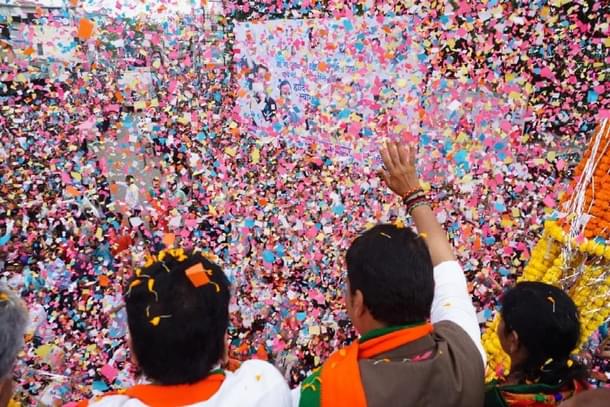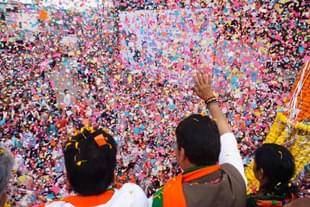Magazine
Devendra Fadnavis: From Unlikely CM To Natural Leader
Aashish Chandorkar
Oct 04, 2019, 07:30 PM | Updated 07:29 PM IST
Save & read from anywhere!
Bookmark stories for easy access on any device or the Swarajya app.


Five years later, he looks set to return to power and become the longest serving chief minister of Maharashtra.
If in October 2014, political observers were asked to opine on the probability of a Brahmin Maharashtra chief minister from Vidarbha in his mid-40s with no cooperative movement link completing a full five-year term, the most common answer would have been “zero”.
Yet, five years later, Devendra Fadnavis is the frontrunner to win another term in the state, having waded through the highs and the lows of his first term, with consummate ease and distinction.
The last chief minister to complete his full five-year term in Maharashtra was Vasantrao Naik in 1972.
Only two out of the 17 chief ministers before Fadnavis — Vasantaro Naik and his nephew Sudhakarrao Naik — had hailed from Vidarbha.
Only one of these 17 chief ministers had reached the highest office in the state younger than Fadnavis — Sharad Pawar was 38 when he became the chief minister. Fadnavis was 44.
Only one of these 17 chief ministers before Fadnavis was a Brahmin — Manohar Joshi of Shiv Sena.
All previous chief ministers had a cooperative or local industrial base, which was their leverage in state politics.
When the Bharatiya Janata Party (BJP) top leadership in Prime Minister (PM) Narendra Modi and party president Amit Shah endorsed Fadnavis for the top job in Maharashtra, the decision was seen as uncharacteristic.
A Maratha chief minister from either Marathwada or Western Maharashtra area was the norm in state politics. Yet, the BJP trusted Fadnavis, not a novice, but certainly not a cookie-cutter template choice either.
The odds facing Fadnavis were insurmountable — he faced opposition from within his party, from within his government and, of course, from the opposition.
So, when on 2 July 2019, Fadnavis ended the last assembly session of his first term on a confident note, he had come a long way. From a Modi-protege to Maharashtra’s most powerful and popular politician with a self-made base, Fadnavis had travelled a long distance.
He thundered — “Mi punha yein, yach nirdharan, yach bhumiket, yach thikani, Nav Maharashtrach nirmiti sathi”.
“I will come again with the same foundation, in the same role, in the same place, to build a New Maharashtra.” This time round, fewer political observers would have been sceptical.
Maharashtra is the economic engine of India, contributing almost 15 per cent of India’s gross domestic product (GDP) and attracting almost 50 per cent of all foreign direct investment (FDI) flowing into India in many years. Yet, politically, Maharashtra had been a cash cow, not a focal point of governance.
The most common reason for politicians to visit the state was the litany of terror attacks since 1993 to express hollow solidarity with its residents.
Mumbai would get the fawning attention, but not the funds to invest in its crumbling infrastructure.
Marathwada got several studies to understand how to deal with perennial water shortage but not many new ideas.
Nagpur got a few projects mainly to ensure the Vidarbha statehood demand remained curbed, but not much in terms of connecting with the rest of the state.
Fadnavis has managed to address several of these anomalies. In some ways, a belligerent ally in Shiv Sena and the risk of the opposition trying to topple his government has played to his advantage. With no political insurance, Fadnavis focussed completely on moving the needle on a few big items.
Rather than getting bogged down by the various scenarios in which he may lose power, he leveraged his urban connect, a person-next-door image and his political vulnerability to create a brand associating himself with development and governance. He worked, talked about his work and got others to talk about his work.
The few big items that Fadnavis concentrated on are at different stages of taking shape. Especially so in Mumbai, several of these projects are now coming together. Over the next six years or so, Mumbai will complete a collection of projects Fadnavis has started or rejuvenated.
All these projects are significantly standalone; collectively they will make Mumbai a very different city. Not yet Shanghai, but certainly the city Mumbai deserved to be a few decades ago, Mumbai will close gap with its own needs significantly.
A 340-kilometre metro rail network will span across Mumbai, Thane and Navi Mumbai areas, making commuting in the city more comfortable and modern.
An expanding suburban rail network will connect Mumbai with several towns in the Konkan region, opening access for job-seekers.
A new airport will come up at Navi Mumbai.
A coastal road — currently blocked by legislative action — will garland the island city. The Mumbai Trans-Harbour Link (MTHL) will connect South Mumbai to the mainland near Jawaharlal Nehru Port Trust.
All of these are significant developments. The new airport was first proposed in 1997. The metro was first conceptualised in 1990s and the current plan was ready as early as 2005. The MTHL is being talked about since 1963.
Successive state governments lacked the will and the conviction to see these projects through. The infrastructure deficit was well known. Fadnavis bridged the will and conviction deficit to get all these projects rolling.
Beyond the city itself, the Fadnavis government is working on the ambitious 710 km Mumbai-Nagpur Samruddhi Mahamarg (literally, the highway of prosperity). With the project achieving full financial closure, the Vidarbha-Khandesh-Konkan connectivity will get a huge boost, opening new markets for farmers as well as industries.
Along the highway, the government plans targeted industrial and residential clusters. The Mumbai-Pune Expressway, connecting two economic powerhouse cities, is also being upgraded to bypass the slow ghat section completely.
Fadnavis has set a target to make Maharashtra drought-free. His flagship Jalyukt Shivar Abhiyan (literally, water-filled fields programme) has covered almost 17,000 villages. Constructing local water harvesting, storage and transporting projects has helped these villages reduce their dependency on rain as well as big dams.
More than half the area of Maharashtra is not amenable to large irrigation and only one-fifth of the area is actually irrigated. Fadnavis changed the government strategy from constructing big dams to encouraging micro-irrigation to find localised solutions.
Maharashtra has also continued to attract domestic and foreign investments. Be it the factories of GE, Philips or Britannia or the retail expansion of Ikea, the state continues to benefit from a stable political environment and being the preferred migration destination of a skilled workforce.
The proposed nuclear power plant in Jaitapur and the oil refinery in Raigad district also promise to add energy to the long list of industries in which Maharashtra leads the country.
How does this all add up?
Devendra Fadnavis has articulated his dream of steering Maharashtra towards a $1-trillion economy. As India targets a $5-trillion economy, this target for Maharashtra makes eminent sense, with its share of GDP over the years. From the current $400-billion-odd levels, it will take 12 years of 8 per cent growth to achieve this feat.
Fadnavis is working on the plumbing in creating the required hard and soft infrastructure to support this ambition. As the state opens up via better connectivity, it will take the load off the Mumbai-Pune-Nashik belt, which has seen mammoth urbanisation and population growth since the turn of this century. Even then, a lot remains to be done.
If Fadnavis is re-elected, he will continue to face opposition emanating from the caste fault-lines of the state. Starting mid-2016, for two years, Fadnavis had to work hard on ensuring that social schisms in the state didn’t snowball into large-scale violent protests. On many occasions, he had to use his personal political capital and goodwill to diffuse frayed sentiments.
Given that Fadnavis implemented the long-standing demand of Maratha reservation, mobilisation of political opposition in the garb of social causes has become difficult.
Additionally, the BJP has also fortified its Maratha leadership ranks. But the ‘Peshwai’ barbs thrown at Fadnavis will remain — a historic reference to the Brahmin Peshwas governing symbolically on behalf of the Maratha rulers, but in essence, edging them out of significance.
Fadnavis runs his government from Mumbai, India’s economic capital. While this brings great glamour to the job, it is a risk in itself. It is the state government’s responsibility to keep the city alive, kicking, moving and functional — all 365 days of the year.
If the financial district of the Bandra-Kurla Complex sneezes, quite likely, Wall Street will catch a cold. If the factories in Chakan or the software firms in Hinjewadi are prevented from operating, global leaders may call New Delhi.
This interdependency reflects the best of global economic integration; it also exposes the city to manipulation. Throwing normalcy out of gear even for a day or two can lead to increased global concern, if not panic.
Mumbai has the most diverse demographic make-up across all large cities in India. This diversity manifests itself in two ways — language and religion.
In a Marathi-speaking state, created on linguistic basis, only 42 per cent residents of the capital city are native Marathi speakers. In terms of religion, Mumbai has 66 per cent Hindus, 21 per cent Muslims, 5 per cent Buddhists, 4 per cent Jains, 3 per cent Christians, and just less than 1 per cent Sikhs.
It is also home to India’s largest population of Parsis, with 60,000 of them living in the city. While this linguistic and religious diversity has contributed immensely to Mumbai’s tenacity and progressive worldview, it sadly also has been a source of strife.
The city has seen many linguistic and religious disputes, often leading to small-scale violence and sometimes large-scale organised riots.
No other Indian chief minister deals with this religious and linguistic diversity in his own capital city as the Chief Minister of Maharashtra. This is the complexity Fadnavis has managed in addition to checkmating his wily political opponents in Sharad Pawar, Raj Thackeray, Ashok Chavan and Prithviraj Chavan, and managing his tantrum-prone ally Shiv Sena.
But this is an ongoing battle if he comes back to run Maharashtra.
A corporator at 25, mayor at 27, Member of Legislative Assembly (MLA) at 29, Fadnavis has spent two decades now in the corridors of power in Mumbai. His no-nonsense, pro-development, less dogma and more action-orientation approach have served him well in his first term.
The expectations will only multiply if he is re-elected. The good news for the state is that after a long time, a chief minister is seeking votes in his own name and work.
Dilli mein Narendra, Mumbai mein Devendra — Narendra (Modi) in Delhi and Devendra (Fadnavis) in Mumbai — that’s the promise BJP has held out to the voters in Maharashtra.
This time, Fadnavis — now the tallest leader in Maharashtra with cross-caste acceptance and not just a budding Brahmin MLA from Vidarbha — seeks to surpass Vilasrao Deshmukh’s record of seven years and 123 days in office as Chief Minister.
Aashish Chandorkar is Counsellor at the Permanent Mission of India to the World Trade Organization in Geneva. He took up this role in September 2021. He writes on public policy in his personal capacity.





